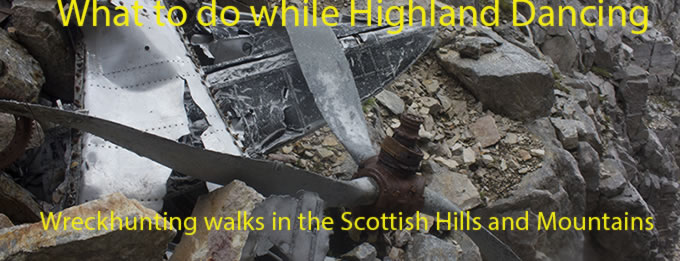Proper Scottish Weather
Hawker Typhoon JR432 nr Loch Skerrow,
Dumfries and Galloway.
(Distance covered = 5.4mile/Ascent =
+162m)
Another monthly competition in Dumfries so another trip along to
Cairnsmore of Fleet National Park for me, to visit the crash site of Avro Anson Eg693 on Craigronald.
This day my luck with the Scottish weather had failed and it was chucking it down, the tops of the nearby hills including Craigronald were well covered with clag and the poor weather was not promising to improve any time soon.. As Craigronald already had the better of me on two previous occasions I decided to revert to plan B and go and look for the crash site of a Hawker Typhoon which was on comparatively lower ground and could be reached by following the old Dumfries to Stranraer railway line. I had previously looked for this crash site back in 1997 but the grid ref I had at the time was out by about 1km.
Big Water of Fleet Viaduct
The first mile of the old railway over the other side of Big Water of Fleet Viaduct is derelict and overgrown but there is a faint path to follow, the only tricky bit being a cutting which is quite boggy and on this day flooded. As I wanted a reason to walk across the Viaduct and as it was also a bit of a shortcut I took the option of walking along the derelict section ignoring a good forest track that can be followed which loops around and joins the course of the railway further along.
As I couldn't see any British Rail Personnel I ignored this sign and carried on.
This Railway was known as 'The Port Road' and was a victim of Dr Beeching and closed in 1965. The Army wanted to blow up Big Water of Fleet Viaduct as a demolition exercise , they had already done this with Little Water of Fleet Viaduct but their request was turned down and the viaduct survived.

A goods train approaching Big Water of Fleet Viaduct which can be seen in the distance in front of the engine
Old Railway tracks were used to strengthen the bridge
during WWII so that heavy ammunition trains could cross safely.
The first mile of track bed on the other side of the viaduct is overgrown
After a mile a good forest road has been laid on the course of the railway.
Once onto the Forest road its quite a monotonous trudge for a couple of miles with nothing but pine trees as scenery.This part of the walk reminded me of the infamous railway section of The Lyke Wake Walk, although in this instance not having already walked through the night across the North York Moors mean 't it wasn't quite as bad.
Very long monotonous section reminiscent of the railway section of The Lyke Wake Walk.
After a very long straight stretch of the old railway line the woods open up a bit on the left and the road is joined by another one coming in from the left, further along just before the road takes a distinct bend to the left to detour around the location of the missing Little Water of Fleet Viaduct, there is the remains of a bridge that used to cross the railway line, the memorial cairn and wreckage of Typhoon JR437 is in the area above and to the left of this. It can be accessed easier by leaving the forest road at the previous mentioned junction then following a quad track that runs parallel to the course of the railway line about 200yrds to the northwest, but as I wasn't aware of that at the time I did it the hard way.
Wreckage of the Typhoon is scattered in ditches in this area, the memorial can be seen
at the centre of the photo.
The rain was kind enough to stop for a while so I could take some photos. Any evidence of where the Typhoon actually crashed has been obliterated by the forestry activity, the remains of the Typhoon have been collected together and dumped in two drainage ditches and some of the larger pieces collected around the memorial cairn.
The biggest remaining pieces have been collected around the memorial.

A Train approaching Little Water of Fleet Viaduct, the location of the memorial is circled. These photos were taken in the 1950's before the introduction of the pine forest

A Train approaching Little Water of Fleet from the opposite direction as the photo above, this train will have just passed the crash site of the Typhoon on its left.
